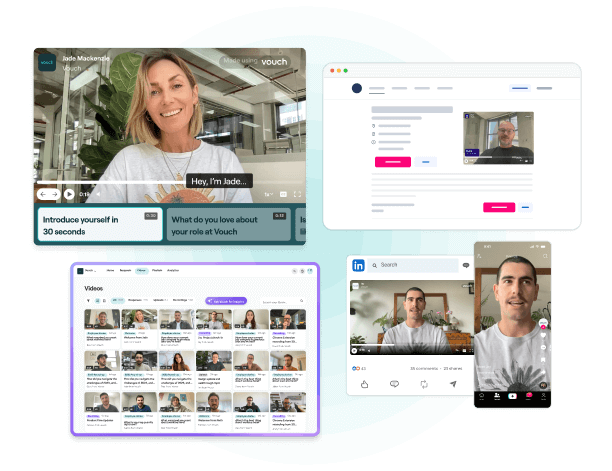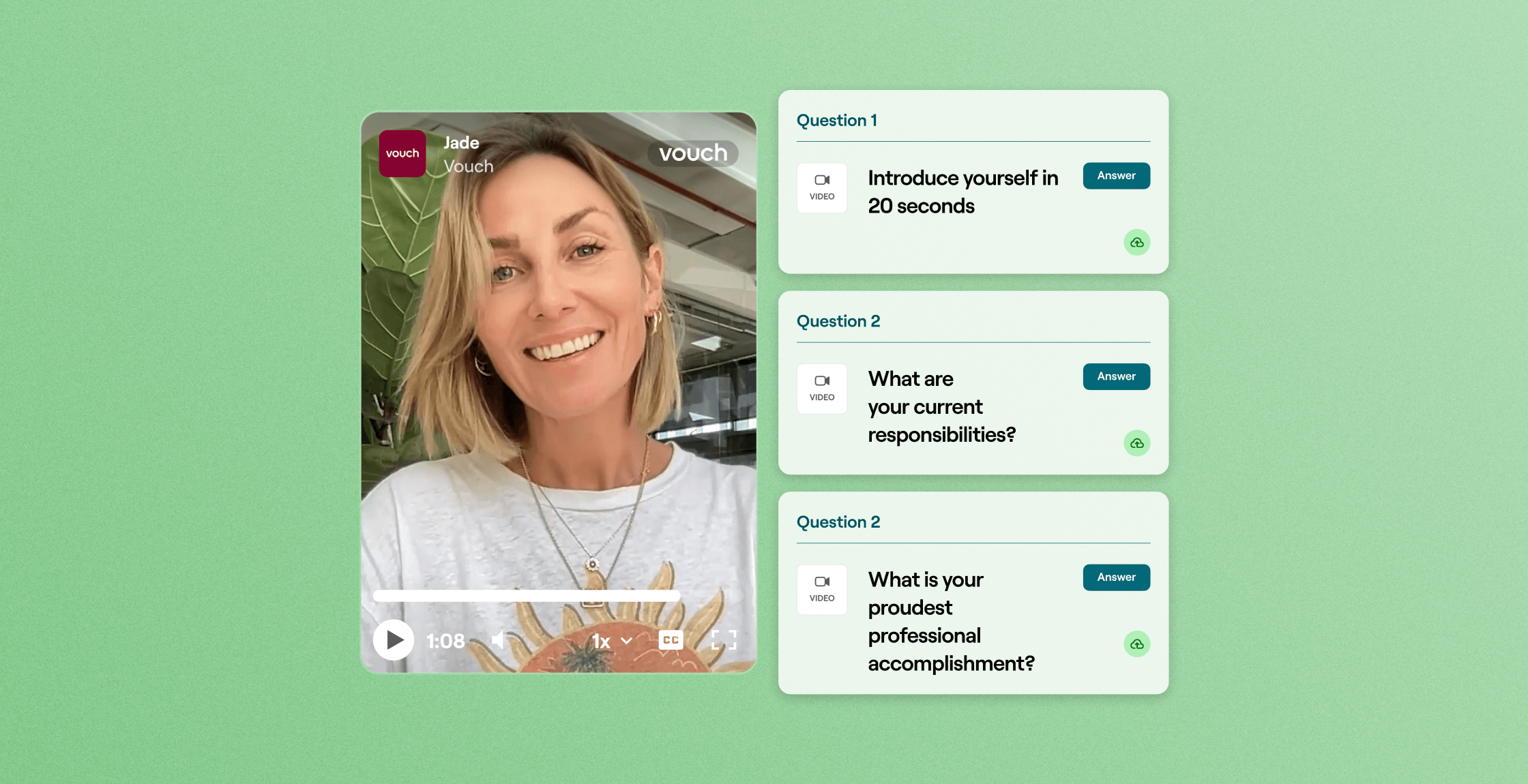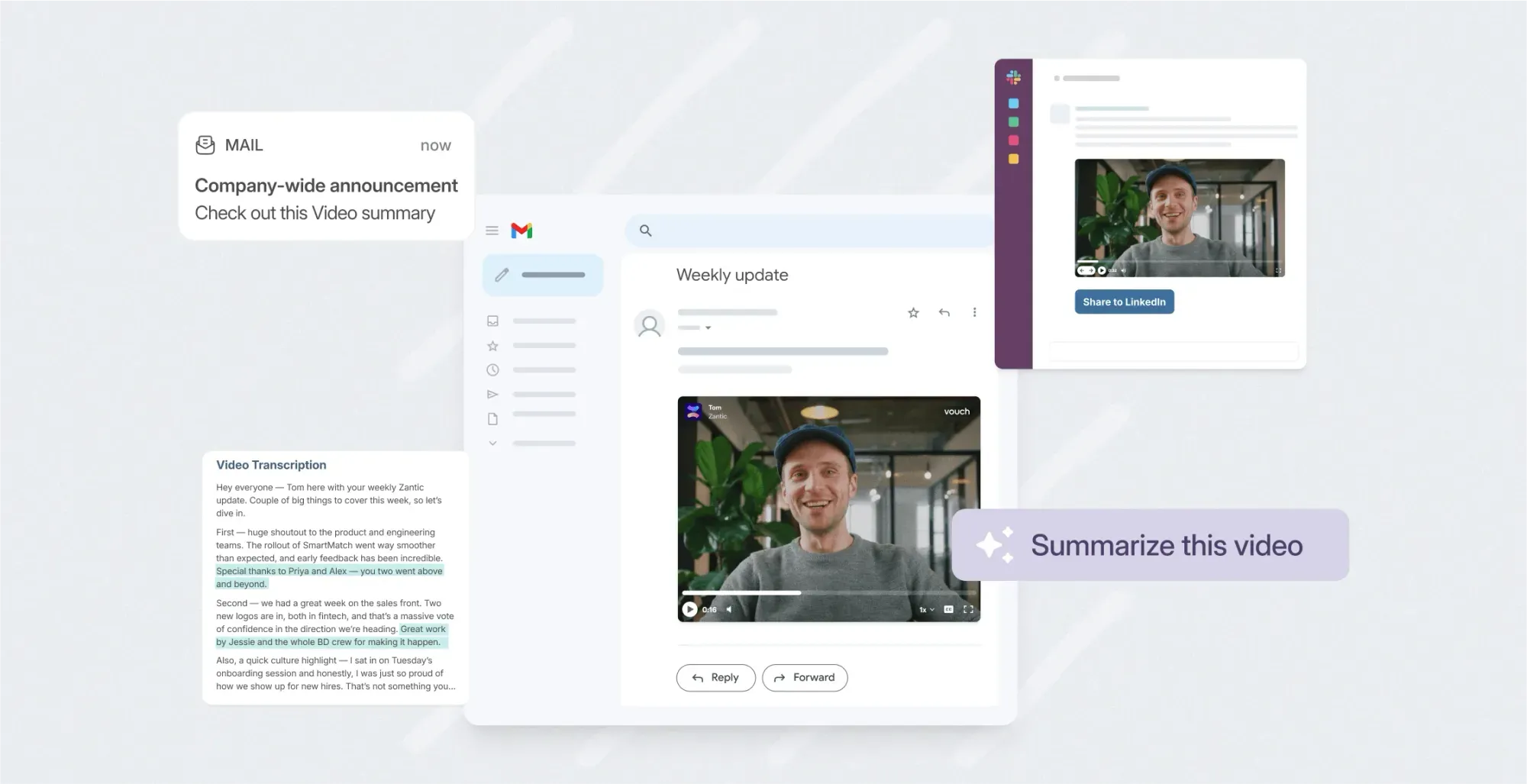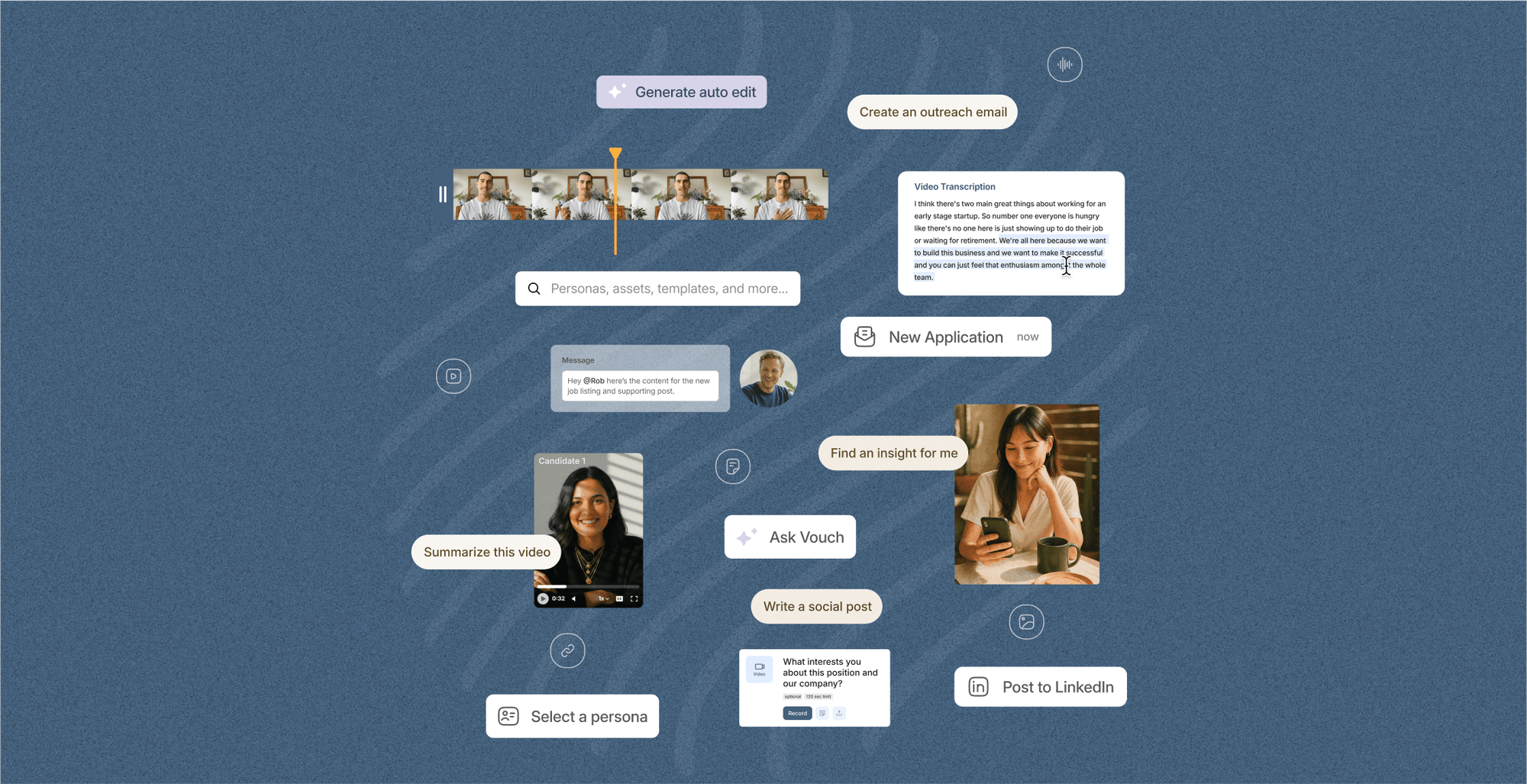If your people are a company's greatest asset, then the hiring process is one of the most crucial components of it, no matter if your organization is big or small.
For hiring and recruitment managers, it's a constant challenge to find and secure the right people - while keeping up with ever-evolving technologies and changing market trends. Companies, hiring managers or talent acquisition teams must stay updated with the latest hiring practices, social media trends, and tech like leveraging video for recruitment to attract and retain top talent.
Needless to say, your hiring journey in 2026 needs to be remarkable.
So let's dive in and help you improve your hiring journey today.
The Definition: What Is The Hiring Journey?
The hiring journey is the experience candidates have when going through your recruitment process, where you find, attract, and onboard new employees.
The hiring journey involves several stages, including promoting your business and positions on channels like LinkedIn and Twitter, which help you build your Employer Brand.
The hiring journey also includes screening applicants, second and third round interviews with potential hires, deciding on the ideal candidate, and finally the job offer. Of course, the goal of your hiring journey is to build a talented and successful workforce that help you drive your company's success.
Why Is The Hiring Journey Important in 2026?
The hiring journey is crucial as it can directly impact the talent you attract, and onboard.
One rockstar hire can transform entire teams, while one bad hire can destroy morale and productivity, including candidate expectations.
As a recruiting manager or talent acquisition specialist, you will know the importance and pressure of building a strong, successful workforce that can drive business growth and innovation, people that are perfect for your company culture, drive productivity and profitability.
Having top talent in your business can be the biggest advantage your company can have in your industry.
Bring your employer brand to life
- Empower employees’ storytelling
- Transform careers sites with video
- AI-driven video editing
- Publish videos anywhere

The 5 Stages Of A Successful Recruitment Journey
When we break down the hiring journey, there are five major steps to consider.
Here is the core hiring journey that most organizations around the world use in 2026:
1. Attracting candidates
The first stage of every hiring journey is attracting not only potential candidates for your open positions, but the right candidates for your company culture.
Technically this can be done through various methods, including traditional job postings, job ads, employee referrals, and social media platforms.
We probably don't need to study traditional methods too much because most companies already do this.
But in 2026, one of the biggest differentiators is how you "present" your company to active candidates. The candidate journey starts with a talented person falling in love with your company and mission. One way to stand out is to build your employer brand through video, and this is exactly what top companies like Canva, Shopify, Amazon, Dropbox, HubSpot do. We know, because they use Vouch!
One popular video format for attracting top talent is "a day in the life" style videos, and we are huge fans of the Google day in the life videos, like this one from Dan Ash.
2. Screening applicants
Once you have a pool of potential candidates, the next stage is screening them to determine their fit for the role. This is also where technology can help your recruiting team, with tools like async video that make screening faster and simpler for you and the candidates, especially across time zones.
In 2026 and beyond, there is an ever-increasing focus on using technology to streamline the screening process.
For example, AI-powered assessment tools can help identify top candidates based on their skills and qualifications, making it easier for recruiters to make informed decisions.
The best part is that these new tools improve your candidate experience too. Let's face it, most people don't love, or are not good at being put on the spot, and with video tools like Vouch, you can give your potential candidates the time and space they need to shine - just as they would in your company once over the nervousness.
Tech like Vouch for recruiting makes a lot of sense for most roles. Of course, for in person roles like sales, you'd want to put the candidates on the spot, but most roles don't really need this level of intimidation on top of the rest of the hiring journey.
3. Interviewing potential hires
After screening and narrowing down your list for the role, the next stage of the hiring journey is conducting interviews with top candidates.
These interviews let you assess a candidate's soft skills, cultural fit, and overall suitability for your role and team.
In step one, we talked about "Employer Branding," and this is where you will see the results of your employer brand efforts. At this stage, almost every short-listed candidate should be eager to work with your company and help you on your mission.
Virtual interviewing tools such as video conferencing platforms will continue to play a significant role in the interview process, especially for remote workers. However, keeping it human is key here. Top talent is looking for a connection to you and your company, so that needs to be at the forefront.
4. Making an informed final decision
One of the trickiest parts of a recruiting manager's role is putting forward their A candidate.
If you have three strong candidates, it feels terrible not being able to hire the other two. Everyone has their strengths and weaknesses, and you can only hope your choice was right.
The good news is that in 2026, companies can access data-driven insights through technologies like predictive analytics and talent intelligence tools. These tools can provide valuable information to help employers make informed decisions while reducing bias in the hiring process.
5. Onboarding and retention strategies
The final stage of the hiring journey is onboarding and retaining new hires.
Employee retention is crucial for companies to reduce turnover costs and maintain a stable workforce, and the first step is ensuring your new employees have an amazing onboarding experience.
In 2026, the key is to create a seamless onboarding experience to engage new employees from day one, showing them you genuinely care about their growth and development.
Additionally, while trends see more people moving back into an office, a remote workforce still makes more sense for many companies (like tech and SaaS). So developing strategies to build a sense of belonging and teamwork among virtual teams is vital, another way Video can help.
9 Ways To Streamline Your Hiring Journey In 2026
Whether you've an established hiring journey or are just starting to build one out, a highly effective hiring journey requires careful planning at every step of the process.
Here are some key steps to help you create a successful hiring journey:
1. Define (or refine) your company's culture and values
Before beginning the hiring journey or any recruitment strategy, it is essential to have a clear understanding of your company's culture and values.
This is in your "Employer Brand," and it will help you attract candidates who align with your organization's mission and vision, leading to better cultural fit and long-term employee satisfaction. Remember, the hiring process is not a short-term investment; you are looking for talented people who can help your company overcome future challenges and drive exponential growth.
Defining and communicating your company brand and values will also help guide decision-making throughout the hiring process.
2. Make your position descriptions simpler
In 2026 it's crucial to make your position descriptions clear and transparent to find the best candidates for your unique roles. All to often, companies get caught up in lengthy job descriptions that can make their company look clunky and complicated from the get-go.
Try to keep job descriptions clean, clear, and straight to the point.
3. Use technology to streamline your hiring process
In our always-on-world, technology like Vouch video plays a significant role in streamlining the hiring process for you, and the hiring journey for your candidates.
By leveraging the latest technology, you can save time and resources while improving the efficiency of your hiring process. For example, resume-screening software can help sift through large volumes of resumes quickly, AI-powered assessment tools can objectively evaluate a candidate's journey, and video conferencing platforms make it easier to conduct remote interviews. Just book a Vouch demo if you would like to know more about the latest technology for recruitment.
4. Share your stance diversity and inclusion
Diversity and inclusion are crucial elements of a successful hiring journey in 2026 and beyond. Company's must strive to create an inclusive workplace by ensuring that their hiring process is fair and free from bias. Incorporating diversity and inclusion into the hiring journey can also attract more diverse candidates, leading to increased innovation, creativity, and overall business success. Most leading companies today have an extremely diverse workforce.
5. Continuously evaluate and improve your hiring journey
Creating a candidate friendly and effective hiring journey is an ongoing process where you need to continuously review and evaluate each stage of the process to identify areas for improvement and make necessary adjustments.
Collecting feedback from new hires and current employees can provide valuable insights into how well the hiring journey works and what changes can be made to enhance it. This is also again where tools like Vouch can help to capture employee feedback and suggestions.
6. Communicate more transparently throughout the hiring process
If you put yourself in your candidates' shoes, the traditional applicant journey can be a terrible experience, with long delays between communications and outdated HR questions that you only see in movies.
Today, clear communication is crucial at every stage of the hiring journey. This helps build trust with candidates and shows that the company values open and transparent communication, which sets a positive candidate experience for future employee-employer relationships.
7. Further personalize your hiring experience
In today's competitive job market, top candidates seek a personalized experience throughout the hiring process. Companies can achieve this by tailoring their job posting videos, further personalizing interviews, and making the onboarding process a remarkable experience. Just book a Vouch demo if you would like to know more about personalizing your hiring journey.
8. Provide genuine support for new hires
Once a candidate is hired, it's crucial to provide them with real human support to succeed in their new roles.
If you have ever worked for a traditional big corporation, chances are you've experienced a poor onboarding process, with minimal team contact, huge PDFs, and procedural guidelines that need to be checked off. It's not a nice experience.
Of course there will always be onboarding information and processes, but try to make them easy to digest, like using video to onboard new hires instead of heavy documents. Supporting new hires is critical, and many companies now have a go-to person who helps them onboard. This could be someone on the same or another team who helps the new hire learn the ropes.
9. Continuously gather feedback
Lastly, you should be continuously gathering feedback from candidates and new hires to identify areas of improvement in your hiring journey. This can help companies make necessary adjustments to create a more efficient, inclusive, and positive experience for future candidates. Again, this is where video shines, and you can use Vouch to gather employee feedback too - in fact, it's perfect for this application.
The Importance Of Social Media And Job Sites Such As LinkedIn for Recruiters and HR
As technology and the way we communicate continues to evolve, building your company's profile on social media is becoming increasingly essential.
Here's why:
- Access to a wider pool of active and passive job seekers: Social media helps companies reach professionals from various backgrounds, expanding opportunities for job openings, collaborations, and partnerships. Platforms like LinkedIn and Twitter provide access to a global network, widening the talent pool and attracting individuals from diverse industries.
- Stay updated on industry trends and advancements: Your company can stay updated on industry trends, statistics, and advancements through social media. Engaging with these posts allows you to connect with experts in the field, making them potential targets for future job openings. Social media provides access to online communities and unique talent pools that may be challenging to reach otherwise.
- Build your company brand and authority: Like staying current, social media can set industry trends and build your company's authority. Sharing valuable insights and expertise through social media platforms or blogs can establish you as a thought leader in your industry—and this could attract some of the world's best talent, who may not even be looking for an open position.
How has company cultures changed over the last 5 years?
Company culture has undergone significant changes over the last five years, driven largely by COVID-19.
There's been a massive shift towards remote work or hybrid working, and the rise of millennial and Gen Z employees entering the workforce has been a considerable learning experience for many. These changes have considerably impacted how organizations operate and what they value in their company culture.
Here are some key ways that company culture has evolved over the last five years:
- Further emphasis on work-life balance: With technology enabling remote work, companies are prioritizing a healthy work-life balance in their culture. Employers recognize the significance of letting employees disconnect from work to focus on personal lives, enhancing job satisfaction and well-being.
- Inclusivity and diversity: Promoting inclusivity and diversity in company culture is gaining momentum. Organizations understand the benefits of a diverse workforce and actively work on inclusive hiring practices and fostering an inclusive environment for all employees.
- Remote work options: The rise of technology has also allowed companies to offer remote work options and source talent from around the world, with many teams now being significantly more diverse. The shift towards remote work greatly impacted company cultures, and employers and employees are still catching up. This is why team collab tools are so important.
- Focus on employee well-being: Organizations increasingly prioritize employee well-being in their company culture. This includes initiatives such as mental health support, wellness programs, and promoting a healthy work-life balance. By investing in employees' well-being, companies see improved job satisfaction, job board, productivity, and retention rates.
- Embracing tech advancements in recruitment social media: As technology has rapidly advanced in the last five years, companies have adapted by embracing digital tools like Slack, social media, and job sites for communication and collaboration.
FAQs
How Can We Ensure a Positive Candidate Experience During the Hiring Process?
To ensure a positive candidate experience, it’s important to provide timely updates throughout the hiring journey, maintain respect for candidates, and align the interview process with company culture and core values.
What Are the Key Stages in the Candidate Journey?
The key stages in the candidate journey include the awareness stage, where job seekers first learn about a job opportunity; the consideration stage, where they evaluate the job role and company; the application stage, where they submit their application; the interview stage, where they engage in interviews and assessments; and finally, the selection and onboarding process, where qualified candidates are offered a position.
How Can We Improve the Candidate Experience During the Interview Process?
Improving the candidate experience during the interview process involves providing timely status updates, clear instructions for interview scheduling, and a well-structured panel interview that aligns with the job role and company values.
What Role Does Employer Branding Play in Attracting Quality Candidates?
Employer branding plays a crucial role in attracting quality candidates by showcasing the company culture, growth opportunities, and core values. A strong employer brand helps potential candidates envision themselves as part of the team and can differentiate the company in a competitive job market, making it more attractive to both active and passive candidates.
How Can Recruitment Teams Address Poor Candidate Experiences?
Recruitment teams can address poor candidate experiences by conducting candidate experience surveys, analyzing feedback, and making necessary adjustments to the recruitment process. Ensuring that the entire recruitment process is transparent, efficient, and respectful of candidates’ time can help prevent negative experiences and improve overall satisfaction.
What Are the Benefits of Using Pre-Employment Assessment Tools in the Selection Process?
Pre-employment assessment tools provide deeper insights into candidates' technical skills, cultural fit, and potential for success in the job role. These tools help streamline the selection process, ensuring that only the most qualified candidates proceed to the next stages, which ultimately leads to better hiring decisions and a more efficient recruitment journey.
How Can We Maintain a Consistent and Engaging Candidate Journey Across All Touchpoints?
Maintaining a consistent and engaging candidate journey requires clear communication, the use of candidate journey maps, and alignment with company values at every touchpoint. From the initial application to the final onboarding process, each interaction should reflect the company’s commitment to providing a positive experience, ensuring that candidates feel valued and respected throughout the entire process.
Conclusion
The hiring journey is an ever-evolving process that organizations must stay up with shifts into more transparent and diverse company cultures.
The constant challenge is to find the right people while keeping up with ever-evolving technologies and changing job market trends. Companies and hiring managers need to stay up-to-date with the latest hiring practices, social media trends, and tech to attract top and retain top talent.
In 2026, the key is to find the software tools that help your hiring team build a seamless hiring journey that is also easy to manage. Vouch is one tool that can help you develop your Employee Brand and create Recruitment Videos that simplify the hiring process.
Streamline Your Hiriing Journey With Vouch!
Loved by companies like Canva, Nike, Cisco, HubSpot, and Amazon, tools like Vouch make leveraging video in your business remarkably easy.
Be sure to book a Vouch demo today and chat with a video content expert.
You might also like

Elevate Your Brand Today With Vouch
Discover how Vouch can accelerate talent acquisition while helping you stay on-brand.






